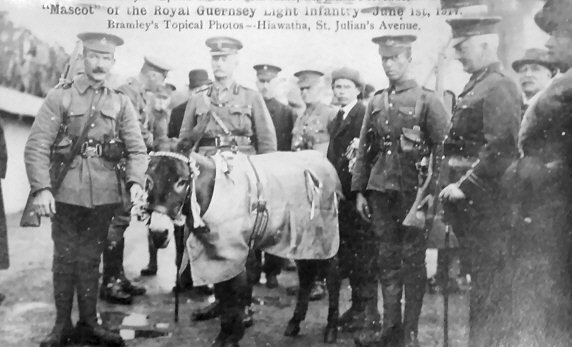| |
The Channel Islands and the Great War |
|
 |
The story of how Joey the donkey
became the mascot of the RGLI is told in Davis
.
He noted that, prior to their departure on 1st
June, 1917 the troops were inspected on the Fort
Field by Colonel H St Leger Wood, DSO, AA and
QMG, in the absence of the Lieutenant Governor.
When bidding the men farewell, he offered them
the choice of a dog or a donkey for the Battalion
mascot. The latter was chosen unanimously, and
the Colonel St Leger Wood is said to have gone
immediately in search of one.
He purchased Joey from Mr George Head, a farmer
of Rouge Rue Farm, St Peter Port, on that same
day.
Joey had previously been used in
town to pull a milk cart driven by Mr Head's son
Stephen, and he was also known as one of the fastest
donkeys on the island, having won the first prize
at Ponchez show in 1914. He was provided with
new shoes and harness, and "a military haircut",
then
decorated with the island colours of green and
white before heading the procession from the Fort
Field, where the men had paraded, to the White
Rock.
At 9.30 in the evening of 1st June,
the men of the 1st (Service) Battalion, RGLI boarded
the Lydia on their way to Bourne Park camp, near
Canterbury, for further training. However, Joey
stayed behind, according to an unpublished memoir
of
Private LT Le Poidevin, RGLI (which formed the
basis for my book, A Guernseyman Goes to War).
He noted that "as I was kept back in the
rear guard, I did not leave before the 14th of
June, 1917, taking the Battalion pet Joey with
us".
What happened after this is unclear,
but Joey appears not to have accompanied the Battalion
to France. Coysh
states that "Later the troops were joined
by their mascot in England, but when they went
to France the donkey returned to Guernsey, where
it rather prosaically drew a milk cart!"
This seems to fit in with Pte Le Poidevin's account,
and also with Joey's previous occupation.
|
Joey was certainly in Guernsey to greet the remnants
of the Battalion on their return to the island on the
"Lydia" on May, 1919. The Weekly Press of
Saturday 24th May carries a picture of Joey with Colonel
St Leger Wood at Number 3 berth awaiting the return
of the Lydia. The accompanying article states that "Quite
an interesting figure at early morning was the donkey,
Joey, the mascot of the RGLI, presented by Colonel H
St Leger Wood, DSO, AA and QMG. Joey was quite in his
element, and trotted up and down the berth as if impatiently
awaiting his old acquaintances, with whom he had marched,
paraded and played with (sic) both here and at Canterbury.
Indeed Mr Henry Head, his keeper, had to keep a close
watch to prevent his gambols exceeding the bounds of
sober liberty."
|
When King George V visited the island
in 1921, he inspected the Militia and ex-service
men, who had marched from the Town Arsenal to
the Connaught Slip. Coysh notes that "The
King's Colour was borne by Lt CTW Clark, and the
band was in attendance, as well as Joey the mascot,
whose ears the King fondled!"
There appears to be no record of
what happened to Joey after this date, until his
death which Coysh recorded thus: "His successor,
Joey ll, attended for the first time at Belvedere
on the King's birthday parade in 1936. It wore
a ceremonial coat, and was accompanied by two
young buglers in full dress. Joey I had died in
Sark some years before". Whether he had remained
with the men, was put out to grass somewhere,
returned to pulling his milk cart, or went directly
to Sark has not been established. However, for
a brief period of time he was not only the fastest
but probably the best known donkey on the island.
|
|
References:
1. Davis, EV (undated),
Sarnia's Record in the Great War (reprinted from The
Star)
2. Guernsey Weekly Press, 2nd June, 1917
3. Guernsey Weekly Press, 9th June, 1917
4. A Guernseyman Goes to War, Liz Walton, pub 2014,
Guernsey Museums
5. Coysh, V, "Old Guernsey"
© Liz Walton 2017
|
| |